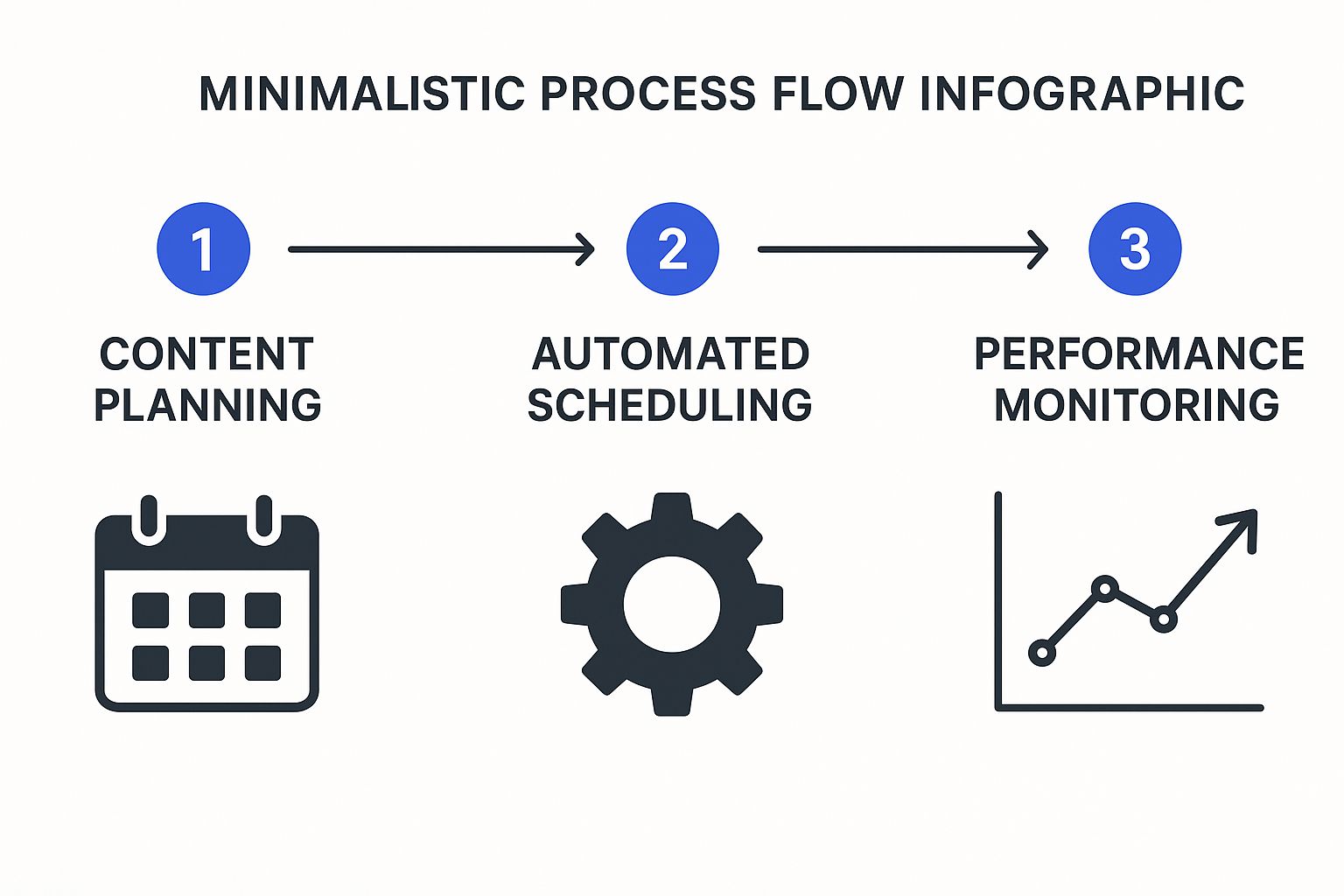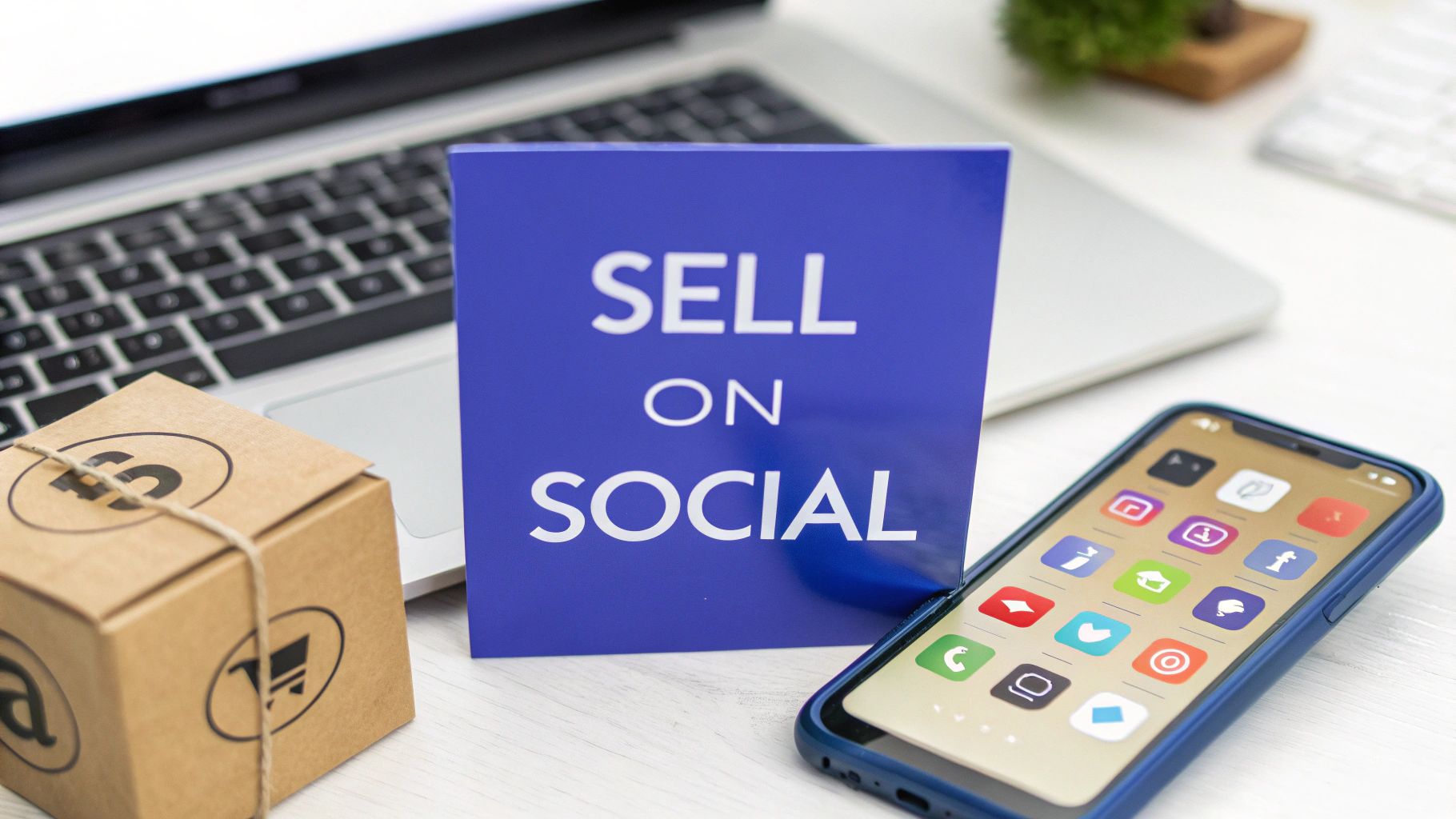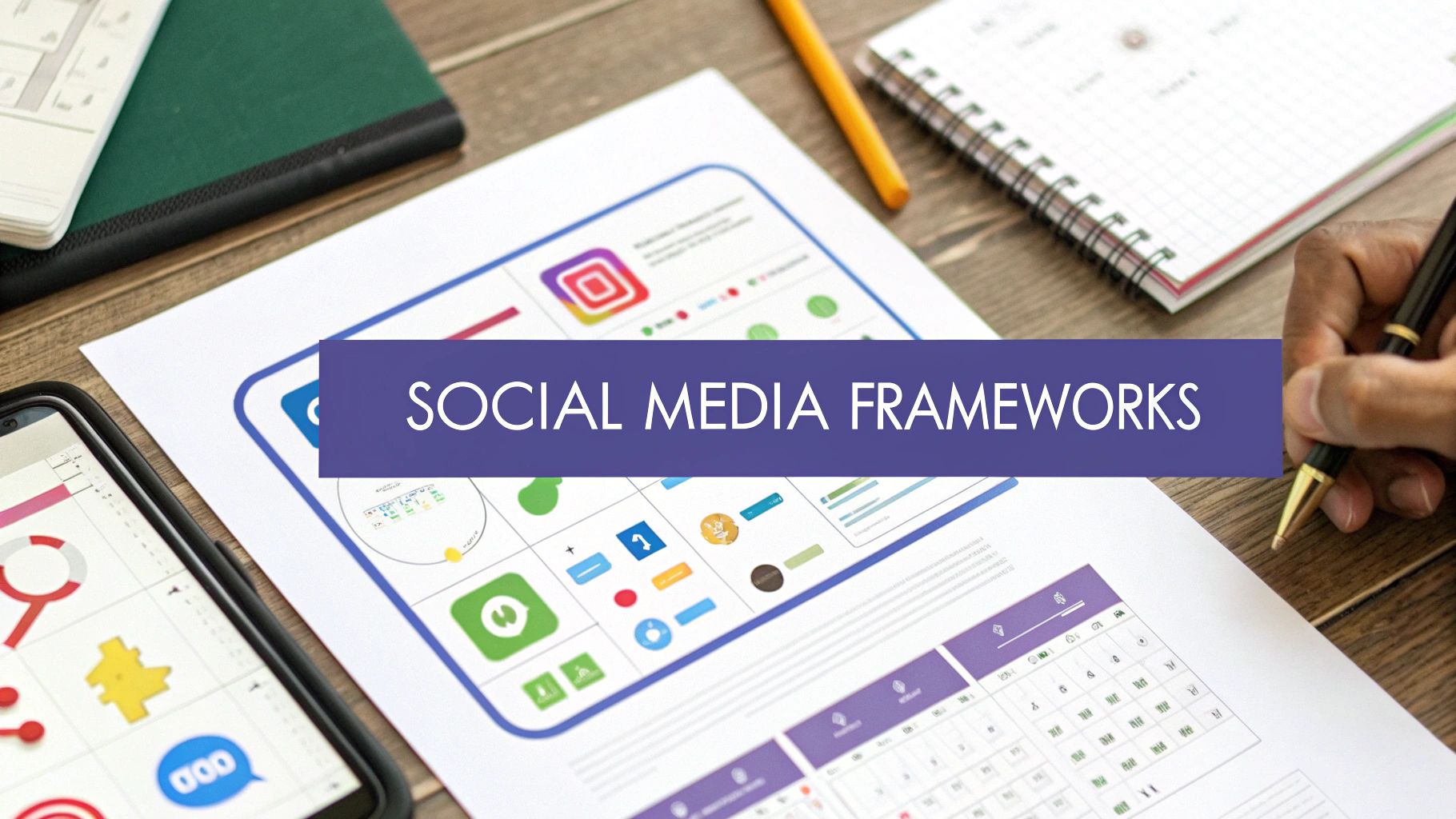Let's be real for a moment. When we talk about social media for ecommerce, we're not just talking about getting likes or building a following anymore. This is about using platforms like Instagram and TikTok to drive actual sales—transforming passive scrolling into active shopping by embedding the entire buying experience right into the feed. It’s a direct line from discovery to purchase, turning followers into paying customers without the usual runaround.
How Social Media Became the Modern Storefront
Not too long ago, social media was just a place to connect with friends and maybe share a vacation photo. For brands, it was a billboard. Now? It’s a bustling digital marketplace. It’s no longer just an outpost for brand updates; it's a primary engine for sales, acting as the modern-day storefront where customers browse, discover, and buy.
This shift isn't just a tech upgrade; it’s a fundamental change in how people shop. The point of sale has moved from a dedicated website to the social apps where we all spend hours every day.
The engine driving this whole revolution is social commerce—the art of selling products directly within social media platforms. Instead of seeing a cool product and clicking a link that whisks them away to an external site, customers can complete their purchase without ever leaving the app. That frictionless experience is everything.
The Power of In-App Shopping
Think about the classic online sales funnel. A customer sees your ad on Instagram, clicks to your website, browses a few pages, adds an item to their cart, and then finally heads to checkout. Every single one of those steps is a potential exit ramp.
Social commerce slashes right through that. A customer sees a shoppable post, taps to see the details, and buys it on the spot. This level of convenience is a massive win for any ecommerce brand.
The real magic happens when you remove friction. The fewer clicks a customer has to make between seeing a product they love and owning it, the higher your conversion rates will be. Social commerce is the ultimate friction-remover.
This streamlined path to purchase is especially potent for impulse buys, which is why brands in fashion, beauty, and home decor are seeing such incredible results.
Which Social Platform Is Right for Your Store
Before you dive in, it’s smart to match your products to the right platform. Each one has its own vibe and audience. Here’s a quick rundown to help you decide where to focus your energy.
| Platform | Primary Strength | Best For These Products |
|---|---|---|
| High-quality visual discovery & shoppable posts | Fashion, beauty, home decor, jewelry, handmade goods | |
| Large, diverse audience & robust ad targeting | A wide range of products, especially for community-driven brands | |
| TikTok | Viral trends & authentic, user-generated content | Unique gadgets, cosmetics, apparel, trendy items |
| Product discovery & long-term planning (e.g., weddings) | Home goods, DIY projects, fashion, recipes, event planning |
Ultimately, the best approach is to test and see where your specific audience hangs out. Don't feel like you have to be everywhere at once. Pick one or two and go all-in.
Why It's More Than Just a Trend
If you think this is all just a passing fad, the numbers tell a different story. With 5.24 billion people now on social media globally, these platforms offer brands an almost unbelievable reach. Better yet, projections show social commerce will balloon to 17% of all online sales worldwide by 2025. That’s a massive slice of the ecommerce pie.
This growth is all about creating interactive shopping moments where users can discover, learn, and buy in a single, fluid experience. To really get a handle on this, it's worth reading up on what is social commerce marketing and how it works for your brand.
This is exactly why tools like PostSyncer have become so essential. They let you centralize your content creation and scheduling, ensuring your virtual storefronts are always stocked, active, and engaging.
A unified dashboard like this is mission control for your social strategy. It gives you a bird's-eye view to manage multiple channels, which is critical for keeping your brand voice consistent across all your new digital storefronts. It turns a potentially chaotic strategy into a clear, manageable workflow.
Building a Sales-Focused Social Media Foundation
A winning ecommerce social media strategy doesn't start with a viral post. I've seen it time and time again—it begins with a rock-solid foundation. Before you even think about what to post, you need to get brutally honest about what success actually looks like for your business. It's time to move past vanity metrics like likes and follower counts and focus on what truly drives growth.
So many brands get stuck chasing engagement without ever connecting it to actual sales. A much smarter approach is to set clear, sales-focused objectives. These are the goals that directly impact your bottom line and give your social media efforts a real purpose.

For instance, instead of just aiming for "more followers," set a goal to increase the average order value (AOV) from social media referrals by 15% in the next quarter. Or, forget "more engagement" and aim to boost customer lifetime value (CLV) by encouraging repeat purchases through exclusive social media offers. See the difference? Now we're talking business.
Uncovering Your Audience's Buying Triggers
Once you know your business objectives, the next step is to get inside your customers' heads. This is my favorite part. You need to understand not just who they are, but why they buy. This deep audience research is what separates generic, forgettable content from posts that truly resonate and convert.
Start by creating detailed customer personas. And I mean detailed. Go way beyond basic demographics and dig into their psychographics.
- What are their biggest pain points? Are they looking for a solution to a nagging problem that your product just happens to solve?
- What content formats do they actually like? Do they engage more with quick video tutorials, in-depth user reviews, or aspirational lifestyle photos?
- Which platforms do they use for discovery vs. purchase? They might browse on Pinterest for inspiration but make their final purchase decision based on an Instagram Story.
Answering these questions helps you tailor every single piece of content to their specific needs and online habits. If you find out your audience loves seeing products in action, you can double down on creating user-generated content (UGC) campaigns and short, snappy video tutorials.
The most effective ecommerce social media marketing feels like a helpful conversation, not a sales pitch. When you deeply understand your audience's motivations, you can create content that solves their problems and builds trust, making the sale a natural next step.
This kind of understanding lets you craft messages that speak directly to their desires and hesitations, making your brand the obvious choice when it's time to buy.
Analyzing Your Competitors and Finding Your Niche
Let's be real: you don't operate in a vacuum. Your competitors are all fighting for your audience's attention, so a thorough competitive analysis is non-negotiable. The goal isn't to copy them—it's to find gaps in the market and opportunities to stand out.
I always recommend identifying 3-5 of your top competitors and analyzing their social media presence with a critical eye.
- Platform Choice: Where are they most active? Are they dominating TikTok but completely neglecting Pinterest? That could be your opening.
- Content Strategy: What types of content are they posting? Is it all heavily promotional, or are they genuinely trying to build a community? Take note of what gets the most engagement—and what falls completely flat.
- Customer Interaction: How do they handle comments and DMs? Are they responsive and helpful, or is their engagement a ghost town? This is a huge opportunity to provide a better customer experience.
This analysis will reveal what's working in your industry and, more importantly, what isn't. You might discover that no one is effectively using Instagram Reels to demonstrate your type of product, giving you a clear path to becoming the go-to resource in that space.
Combining this competitor research with your audience insights gives you a powerful roadmap. You'll know exactly which channels to focus on and what kind of content to create. This strategic planning also makes it far easier to map out your content calendar—a process that becomes incredibly simple with smart social media scheduling.
Once your foundational strategy is set, using a tool like PostSyncer becomes your execution powerhouse. It allows you to schedule your carefully planned content across the channels you’ve identified as most valuable, ensuring your message reaches the right audience at exactly the right time.
Creating Content That Turns Followers Into Customers
Let's get one thing straight: effective ecommerce content is more than just pretty pictures designed to fill up your feed. It's the engine that closes the gap between a casual scroll and a confident purchase. It’s not about screaming “buy now!” at every opportunity. It’s about creating genuine desire and trust, making the decision to buy feel like the most natural next step for your follower.
This means you have to move beyond just posting basic product photos. Your content needs to tell a story, solve a problem, or paint a picture of a lifestyle that your ideal customer wants to be a part of. It’s where art and science collide—blending persuasive storytelling with what the data tells you to create posts that don't just get likes. They get sales.

Go Beyond the Product Shot
High-quality product images are table stakes—they're the bare minimum. The real magic in ecommerce social media happens when you start diversifying your content. Each format plays a different role in building that crucial relationship with your audience.
Here are a few powerhouse content types I’ve seen deliver serious results for online stores:
- User-Generated Content (UGC): Nothing builds trust faster than seeing real people using and loving your products. Encourage your customers to share photos and videos with a unique brand hashtag, then feature the best ones. This is authentic social proof that’s far more convincing than any ad you could ever create.
- Shoppable Video Tutorials: Show, don't just tell. Create short, snappy videos—think Instagram Reels or TikToks—that demonstrate how to use your product, solve a common pain point, or achieve a certain look. By tagging the products right in the video, you create a frictionless path from "Oh, that's cool" to "Add to Cart."
- Authentic Influencer Collaborations: Find creators who genuinely fit your brand’s vibe and have a real, engaged audience. The key here is authenticity. Ditch the scripted ads and let them weave your product into their natural content style. It lands like a trusted recommendation from a friend, not a corporate sponsorship.
Mixing these formats keeps your feed from getting stale and speaks to customers at every stage of their journey, from just discovering you to being ready to buy.
Writing Copy That Converts
Your visuals might stop the scroll, but your copy is what seals the deal. Good social media copy isn't about being pushy; it's about being helpful, engaging, and clear. Every caption should have a purpose, whether it's to educate, entertain, or get someone to take a specific action.
A simple framework I always come back to is: Hook, Value, Call-to-Action (CTA).
- Start with a punchy first line that grabs attention.
- Follow up by highlighting a key benefit or solving a customer's problem.
- Finally, tell them exactly what you want them to do next with a crystal-clear CTA, like "Tap the link in our bio to shop the collection" or "Drop your favorite color in the comments!"
A classic mistake is getting hung up on product features instead of customer benefits. Remember the old saying: no one buys a drill because they want a drill; they buy it because they want a hole. Always frame your copy around the outcome your product delivers.
This benefit-first approach makes your product feel like a solution, not just another thing to buy. It connects on an emotional level, which is a powerful driver for any purchase.
Balance Promotion with Value
A killer ecommerce social media strategy is a balancing act. If your feed is a constant stream of "buy this," you'll tune your audience out fast. You have to earn the right to sell by consistently providing value that has nothing to do with a sale.
A great rule of thumb is the 80/20 principle: 80% of your content should be valuable, engaging, and community-focused, while only 20% is directly promotional.
This "value" content can be things like:
- Educational Tips: A skincare brand could share a morning routine guide.
- Behind-the-Scenes: Show the people and process behind your brand. It humanizes your business and builds a real connection.
- Community Spotlights: Feature your followers, run polls, and ask questions to make your audience feel like part of the conversation.
Knowing what your audience actually cares about is crucial to nailing this balance. This is where social listening becomes so important. It’s about tuning into online conversations to get real-time consumer insights. In fact, social media pros who use social listening are much more confident in proving the ROI of their work. You can discover more about these social media trends and see how data is shaping modern strategies.
By truly listening, you can build a content calendar that feels less like an ad schedule and more like a trusted resource. That’s how you build a loyal community that not only trusts your brand but is genuinely excited to buy from you.
Putting Your Social Media Campaigns into Action (And on Autopilot)
A brilliant social media strategy is a great start, but it's the execution that separates the winners from the rest. The good news? Flawless execution doesn't mean you need to work around the clock. It's about building a smarter, more automated workflow that turns your grand plans into consistent, daily action.
This is where you move away from tedious, manual tasks. To really get your ecommerce social media off the ground and scale it, using the right social media automation tools isn't just a nice-to-have—it's essential. Think of these platforms as your command center, transforming a chaotic to-do list into a smooth, streamlined process.
This visual breaks down how a smart, automated workflow really works, from the initial planning stages right through to checking your results.

As you can see, automation does the heavy lifting every step of the way. This frees you up to focus on the creative and strategic parts of your job—the things that actually grow your business.
Mastering Your Posting Schedule
Just posting "whenever you have a spare minute" is a surefire way to get mediocre results. A well-timed posting schedule is your secret weapon for getting your content seen, but it's not based on guesswork. It's about knowing exactly when your audience is scrolling and ready to engage.
This is where a tool like PostSyncer really shines. It digs into your past performance and audience data to pinpoint the absolute best times to post on each social network. It's a data-driven approach that takes the "what if" out of scheduling.
Remember, your goal isn't just to publish content; it's to spark a conversation. When you schedule posts for peak times, you're more likely to be online right when the first comments and questions start rolling in. This lets you jump in, engage in real-time, and give the algorithm a nice little nudge.
That first wave of interaction can make a massive difference in a post's reach and staying power.
A Single Dashboard to Rule Them All
Let's be real: juggling multiple social media accounts is a huge time-suck. Logging in and out of different apps to post, check DMs, and reply to comments is not only inefficient but also leaves a lot of room for error. A unified management tool solves this exact headache.
With a centralized platform like PostSyncer, you can run your entire social presence from one place.
- Schedule Everything in Advance: Plan out your posts across all your profiles for weeks or even months ahead of time.
- See Every Interaction: Manage all your comments, DMs, and mentions from every platform in a single, organized inbox.
- Keep Your Assets Handy: Store all your approved photos, videos, and graphics in one central library for quick and easy access.
For instance, using a specialized Facebook scheduler that's part of the PostSyncer system means you can sit down and batch-create all your Facebook content for the week in one go. No more daily scramble to figure out what to post.
For ecommerce brands, having the right features in your social media management tool is critical. It's not just about scheduling; it's about having a toolkit that directly supports your sales and marketing goals.
Essential Social Media Management Tool Features
| Feature | Benefit for Ecommerce | How It Saves Time |
|---|---|---|
| Unified Inbox | Never miss a sales inquiry or customer question, regardless of platform. | Consolidates all DMs and comments, eliminating the need to log into multiple apps. |
| Bulk Scheduling | Plan and upload an entire month's worth of content in a single session. | Frees you from the daily pressure of creating and posting content. |
| Content Calendar | Visualize your entire campaign schedule to spot gaps and opportunities. | Simplifies strategic planning and ensures a balanced content mix. |
| AI-Powered Best Time to Post | Maximize reach and engagement by publishing when your audience is most active. | Removes the guesswork and manual analysis of audience activity data. |
| Media Library | Centralize all your product photos, videos, and brand assets for easy access. | Stops the frantic search for creative assets across different folders and drives. |
Investing in a platform with these core features is the foundation for a scalable and efficient social media operation.
Turning Conversations into Sales
For an ecommerce brand, community management is a sales activity, plain and simple. Every comment and direct message is a chance to answer a last-minute question, build trust, and guide a potential customer toward making a purchase.
This is why a unified inbox is so crucial. It guarantees that no customer query ever falls through the cracks. When you can reply to an Instagram question just as quickly as a Facebook comment, you deliver a professional and seamless experience that builds confidence.
Pro Tip: Set up saved replies for your most frequently asked questions. Think "What's your return policy?" or "Do you ship to my country?" This saves a ton of time but still gives customers the fast, helpful answers they need to click "buy."
Measuring Performance and Optimizing for Growth
Is your social media strategy actually making you money? That’s the real question, isn't it? As an ecommerce brand, you can create amazing content all day long, but if you can’t connect it to sales, you’re just flying blind. It's time to stop guessing and start answering that question with hard data.
This isn’t about chasing vanity metrics like likes or follower counts. I’m talking about digging into the key performance indicators (KPIs) that directly link your social media grind to your store's bottom line. You absolutely need to know if the time, effort, and money you're pouring in are actually delivering predictable growth.

Identifying the KPIs That Actually Matter
For any ecommerce business, the metrics that truly move the needle are almost always tied to sales and profitability. Engagement is a great sign of a healthy community, I get it. But it’s a means to an end. The real victory is turning those clicks and comments into paying customers.
Here are the core ecommerce KPIs you should be obsessed with:
- Conversion Rate: This is your golden metric. It's the percentage of people who click a link in your social post and go on to make a purchase. A high conversion rate is proof that your message, product, and audience are perfectly in sync.
- Cost Per Acquisition (CPA): How much are you spending to get one new customer through a specific social media campaign? Knowing your CPA is fundamental to understanding if your ad spend is even profitable.
- Return on Ad Spend (ROAS): This one is simple but powerful. For every dollar you put into social media ads, how many dollars do you get back in revenue? A 4:1 ROAS means you’re making $4 for every $1 spent. It’s the ultimate report card for your ad campaigns.
When you focus on these numbers, the conversation shifts from "How many people liked our post?" to "How much revenue did that post generate?" This data-first mindset is the foundation of any scalable social media strategy.
Leveraging Your Analytics Dashboards
You're sitting on a mountain of data, whether you realize it or not. It’s all there in your native platform dashboards (like Meta Business Suite or TikTok Ads Manager) and, of course, in comprehensive tools like PostSyncer. The trick is knowing how to weave them together to see the full picture.
Native analytics are fantastic for platform-specific details—like finding the best time to post on Instagram or seeing which ad creative is killing it on TikTok. But a centralized dashboard is where you get the bird's-eye view. It lets you compare performance across all your channels in one spot, so you can instantly see if your Pinterest campaigns are delivering a better ROAS than your efforts on Facebook.
Data is just a collection of numbers until you turn it into a story. Your job as a marketer is to read that story and use it to make smarter decisions—to cut what's failing and double down on what's winning.
Understanding the financial impact of your social media is non-negotiable. Learning how to measure social media ROI effectively is the key to proving your marketing's value and securing the budget you need to grow.
Turning Data into Actionable Growth Strategies
Collecting data is the easy part. It’s what you do with it that separates the pros from the amateurs. Your analytics should fuel a relentless cycle of testing, learning, and optimizing.
The scale here is massive. Global spending on social media advertising is projected to hit a mind-boggling $276.7 billion by 2025. And the numbers show why brands are investing so heavily. The average conversion rate for social ads is an impressive 9.21%, with an average CPA of just $18.68. With numbers like these, brands that track their metrics can achieve seriously measurable returns.
This is exactly why A/B testing isn't just a "nice-to-have" activity—it's essential.
- Test your creative: Run the same ad with two different images. Which one gives you a lower CPA?
- Test your copy: Pit a long, story-driven caption against a short, punchy one. Which one gets more clicks?
- Test your audience: Target two different demographics or interest groups. Which one delivers a higher ROAS?
The results give you a clear path forward. If you discover that video ads featuring customer testimonials outperform your slick product shots by a 3x margin, you know exactly what to do. You shift your budget and your focus to create more of what works.
This constant feedback loop is what separates stagnant brands from the ones you see experiencing explosive growth. For a deeper dive, our guide on proven social media growth strategies offers even more techniques for turning insights into scalable success.
Ultimately, optimization is about making small, continuous improvements that compound over time, transforming your social media from a cost center into a powerful, revenue-generating machine.
Alright, let's get into some of the questions I hear all the time. Even when you've got a killer strategy mapped out, the world of ecommerce social media can still throw you a few curveballs. Consider this your go-to cheat sheet for tackling those common hurdles head-on.
How Much Should an Ecommerce Business Budget for Social Media?
This is the million-dollar question, isn't it? While there’s no single number that fits everyone, a good rule of thumb for most small to mid-sized ecommerce brands is to earmark around 7-12% of your total revenue for social media.
This isn't just for making pretty posts. That budget needs to cover your tools (like PostSyncer, of course), any content creation costs, and—most critically—your paid ad spend. I can't stress this enough: in today's pay-to-play environment, you can't rely on organic reach alone. A dedicated ad budget is non-negotiable for growth.
But don't just light a pile of money on fire. Start smart. I always advise clients to kick off with a small, controlled test budget. We're talking $10 to $20 a day on whatever platform looks most promising. The goal here is simple: find out which ads and audiences actually work without breaking the bank.
Once you see a positive return on ad spend (ROAS) and know your customer acquisition cost (CAC), that's when you can confidently start turning up the dial. Let the data tell you where to put your money. If a campaign is making you money, give it more fuel.
Key Takeaway: Stop thinking of your social media budget as a cost. It’s an investment in predictable, scalable growth. Prove what works on a small scale, then double down. It’s the safest way to get the best return.
This isn't just spending; it's a methodical investment into the channels that are actively feeding your bottom line.
Which Social Media Platform Is Best for Selling Products?
The "best" platform isn't about the platform itself. It's about your people. Where do they hang out? How do they discover new things? Trying to be on every single platform is a fast track to burnout and watered-down results. Focus is your friend.
- For anything visual—think fashion, home decor, or beauty products—Instagram and Pinterest are your heavy hitters. They are built for discovery and inspiration, with features like shoppable tags and product pins that seamlessly bridge the gap from "ooh, I love that" to "add to cart."
- Facebook is still the reliable all-rounder. With its massive user base and incredibly granular ad targeting, it’s a solid bet for almost any type of product. It's particularly powerful for brands that benefit from community building or products that need a bit more storytelling.
- TikTok has absolutely exploded, especially if you're trying to reach Gen Z and younger Millennials. This is the place for authentic, high-energy video content. If you sell trendy gadgets, cosmetics, or unique apparel, a viral TikTok can change your business overnight.
My advice? Figure out where your ideal customers are most active and start there. Master one or two core platforms. Once you have a profitable system humming along, then you can think about expanding.
How Can I Increase Engagement on My Ecommerce Posts?
If you want more engagement, you need to stop broadcasting and start conversing. It's the difference between collecting an audience and building a community. When people feel like they're part of something, they're not just more likely to engage—they're more likely to buy.
First things first, create content that gives them something valuable beyond just a product picture. Show them how to use your product in a cool way, take them behind the scenes of your business, or share tips that solve a real problem they have.
Next, you have to actually ask for interaction. It sounds simple, but so many brands forget to do it. End your captions with a question. Run a fun poll in your Stories. Launch a giveaway that gets people tagging their friends.
A tactic that works like magic is leaning into user-generated content (UGC). Actively encourage your customers to share photos with your products and then feature them on your feed. There is no social proof more powerful than seeing real people enjoying what you sell. It’s infinitely more trustworthy than an ad you paid for.
Finally, be human. When someone leaves a comment, reply to it. When you get a DM, answer it—and do it quickly. These small interactions show that there's a real person behind the brand who actually cares. That’s how you create not just customers, but true brand advocates.
Ready to put these strategies into motion? You can streamline your entire workflow—from planning and scheduling to seeing what’s working—with PostSyncer. Stop juggling a dozen tabs and start building a smarter, more profitable social media presence. Start your 7-day free trial of PostSyncer now.















